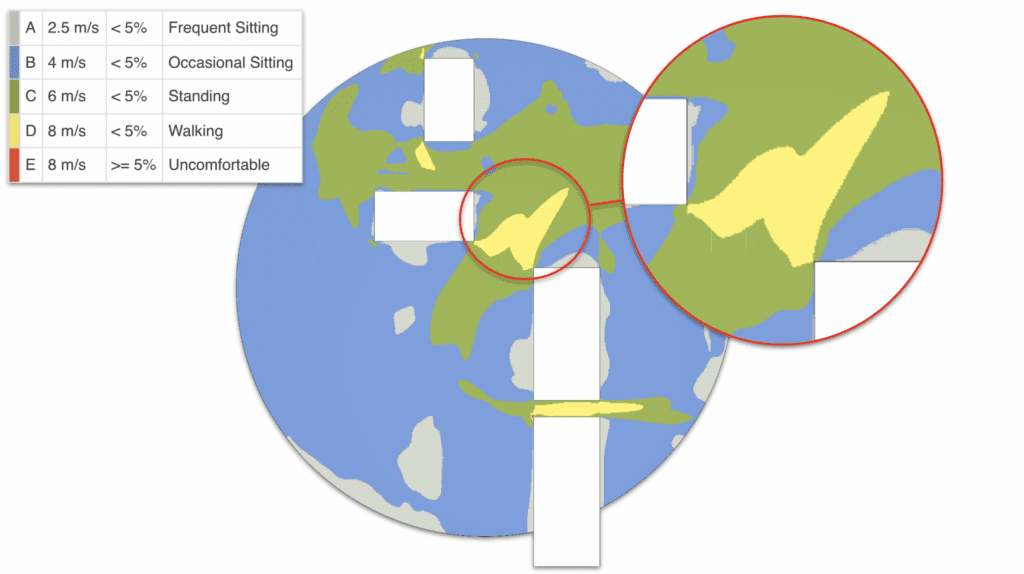As you traverse the bustling city street, attempting to immerse yourself in the vibrant surroundings, a pervasive challenge dampens your experience: an incessant, turbulent wind that engulfs the entire area. The wind channeling effect (known sometimes as the Venturi effect), a phenomenon that plagues the street you tread upon, amplifies the wind’s strength and disrupts your journey. Every step becomes a battle against the unrelenting gusts that dominate the entire stretch.
In this blog post, we explore the complexities of pedestrian wind comfort, delving into the far-reaching impacts of the channeling effect and unveiling five strategies to combat its relentless grasp. Join us on this expedition as we uncover innovative solutions to restore tranquillity and ease to the wind-ravaged streets, reimagining them as havens of pedestrian comfort.
What is the Channeling Effect (Funneling Effect of Buildings)?
To comprehend the impact of the channeling effect on pedestrian comfort, it is crucial to delve into its intricate mechanisms and dynamics. The channeling effect, an intricate phenomenon prevalent in urban environments, shapes the wind patterns that pedestrians encounter. As wind traverses the built environment, its encounter with building gaps, corners, and intersections sets off a chain reaction of accelerated airflow, intensifying its force and creating localized areas of turbulence. In this section, we explore the underlying principles of the channeling effect, unravel its contributing factors, and gain insight into how it affects pedestrian experiences. By understanding the intricacies of this phenomenon, we can better grasp the challenges it poses and pave the way for effective mitigation strategies.
Wind Flow Patterns and Pressure Distribution
The channeling effect is a wind phenomenon that occurs when the wind is funneled between buildings of close proximity, increasing wind speed and intensifying the wind as it flows through the channel. This funneling phenomenon is commonly observed at intersections where tall buildings create a focused pathway for the wind. As the wind passes through the gaps and spaces between the buildings, its speed intensifies, resulting in higher wind velocities. The buildings can also influence the direction of the wind, deflecting or redirecting it within the channeled zone.
Recognizing the Channeling Effect
One of the most powerful tools for understanding and mitigating the channeling effect is Computational Fluid Dynamics (CFD). This advanced technology enables engineers and designers to simulate and analyze the complex wind flow patterns, pressure distributions, and velocity fields that occur within urban environments. By harnessing the capabilities of CFD, we can visualize how wind interacts with the unique geometry of buildings and street layouts, uncovering areas of accelerated wind speeds and turbulent conditions. This valuable insight gained through CFD simulations empowers us to develop targeted strategies that enhance urban design and improve pedestrian wind comfort. In the following sections, we go through the journey required to identify the channeling effect using CFD. This becomes easier over time, and identifying the effect will become increasingly intuitive.
Comfort Plot
Comfort plots provide valuable information about the comfort levels of specific areas within a designated space. These plots depict zones where pedestrian activities are either comfortable or uncomfortable due to the influence of the channeling effect. By examining comfort plots, designers can identify areas prone to intensified wind flow and gusts, which directly impact pedestrian comfort.
Look for higher comfort categories in areas such as gaps between buildings, long straight streets with tall buildings, and converging lines in building layouts. Comfort plots usually highlight an issue, and we need to apply some intuition to identify the effect. In our further discussion, we will delve into the analysis of wind speeds and directions, exploring how they can better contribute to identifying the channeling effect and its subsequent impact on pedestrian comfort.
Directional Wind Speeds
Given the comfort plot, we can identify that an area in our design exists that is uncomfortable due to some wind effects. But we could not concretely identify the channeling effect from the cornering or downwash effect. To do this, we need to look at the results from different directions, inspecting mainly the wind speed results. By examining the wind rose diagram, we can identify the prevailing wind direction for initial clues to potential channeling locations.
Looking closely at the same area we identified as uncomfortable, we can see high wind speeds passing between the buildings. As the flow moves closer to the constricted place, the wind increases until it separates around the corner of the building. It is this pattern you can look out for to positively identify the channeling effect.
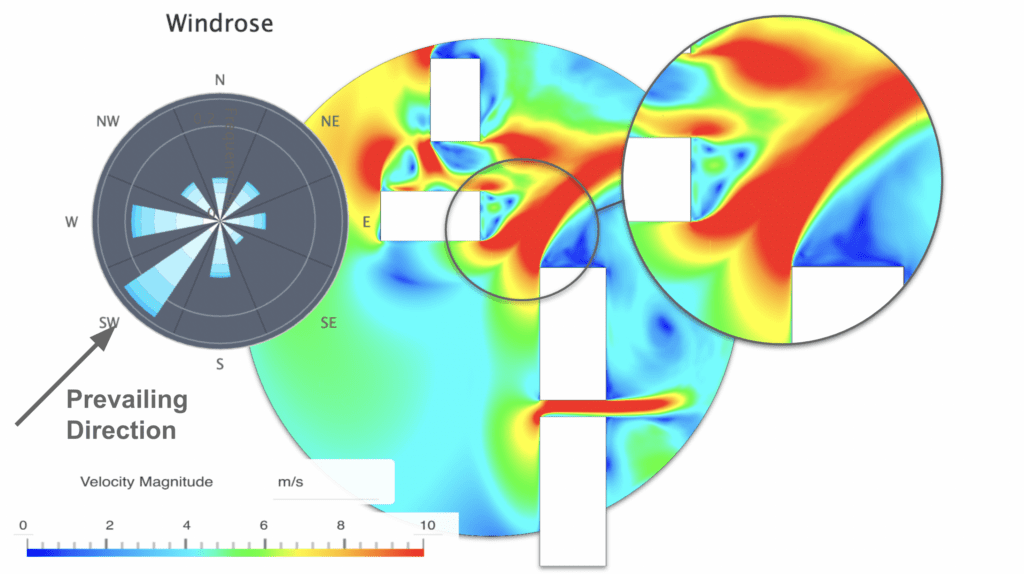
5 Strategies for Mitigating the Channeling Effect
1. Building Design
When it comes to mitigating the channeling effect, building design plays a crucial role. Through careful consideration of orientation, shape, and features, buildings can be designed to minimize wind impacts and create a more comfortable environment for pedestrians.
Key points to consider:
- Take into account building orientation and shape to enhance wind dispersion.
- Incorporate setbacks or indents in building facades to disrupt wind flow.
- Design features that act as wind deflectors or windbreaks.
Let’s consider a simple change that adds a bevel to the shape of the building:
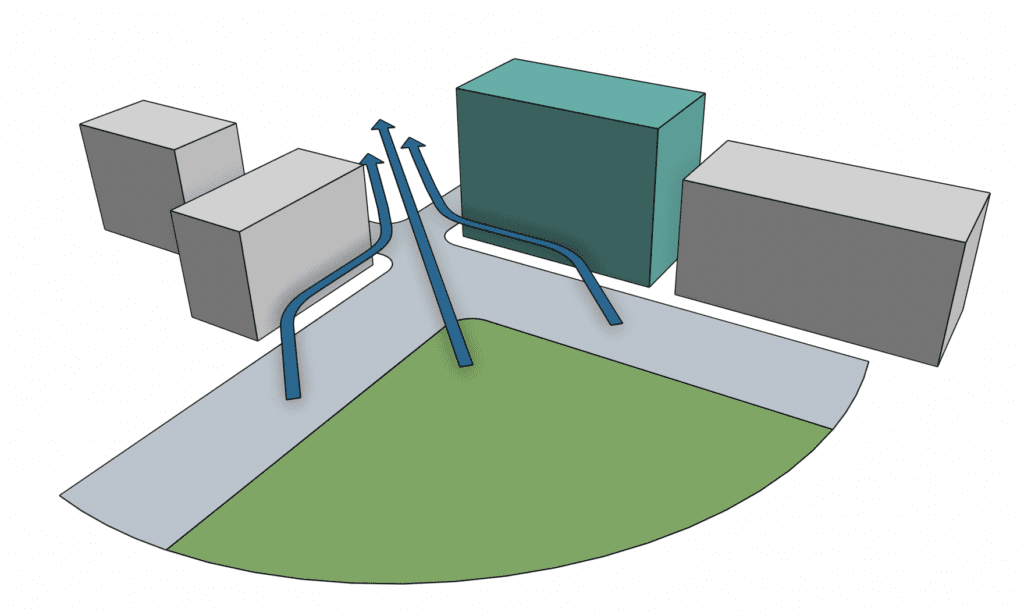
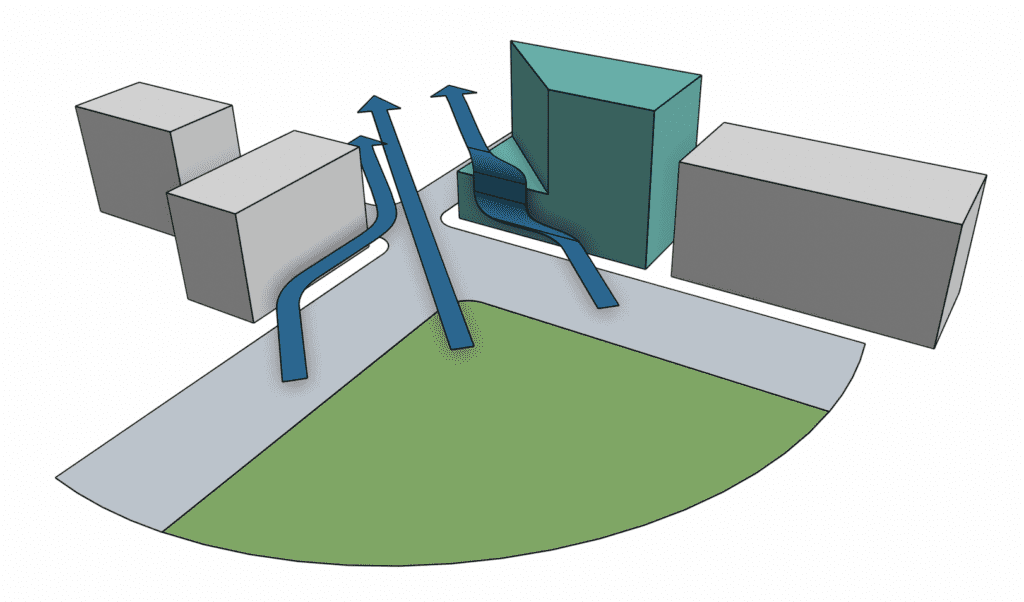
In our design for a new mixed-use building on a windy urban street corner, where the prevailing wind direction is from the southwest, we introduce a chamfer on the upper half of the building’s windward corner. This beveled edge skillfully redirects the wind upwards and over the building, effectively preventing it from being funneled between the buildings at ground level. As a result, wind speeds are reduced, and pedestrians experience improved wind comfort. The previously intense wind speeds are relieved, and the affected area is reduced, creating a more harmonious and inviting pedestrian environment.

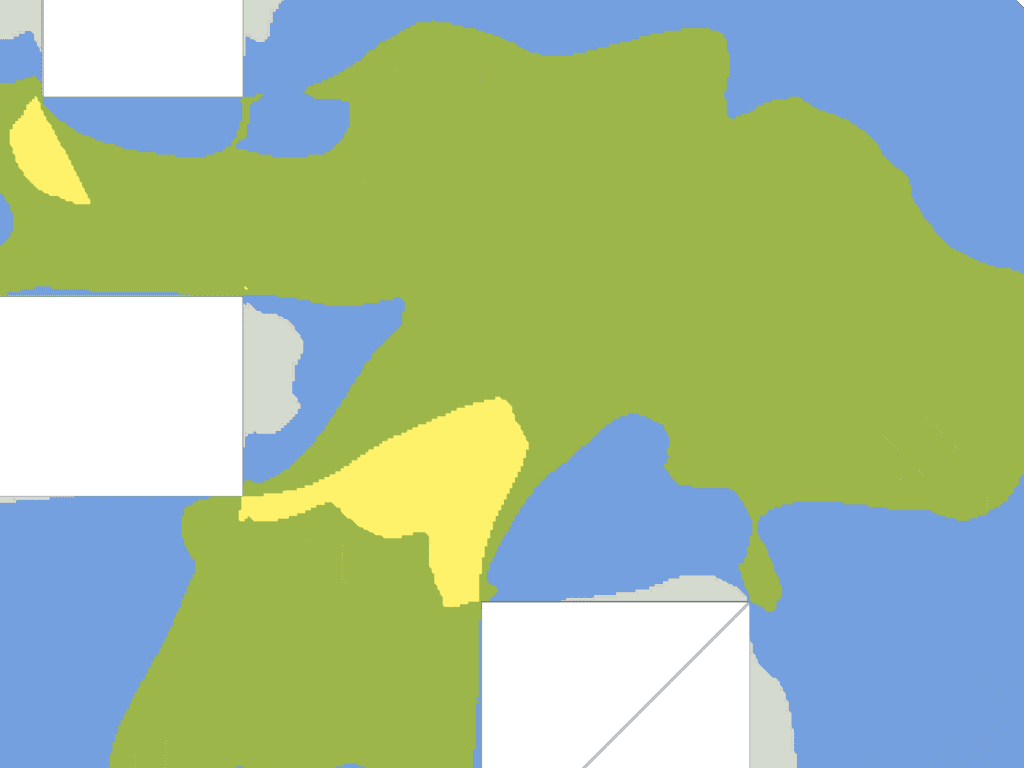
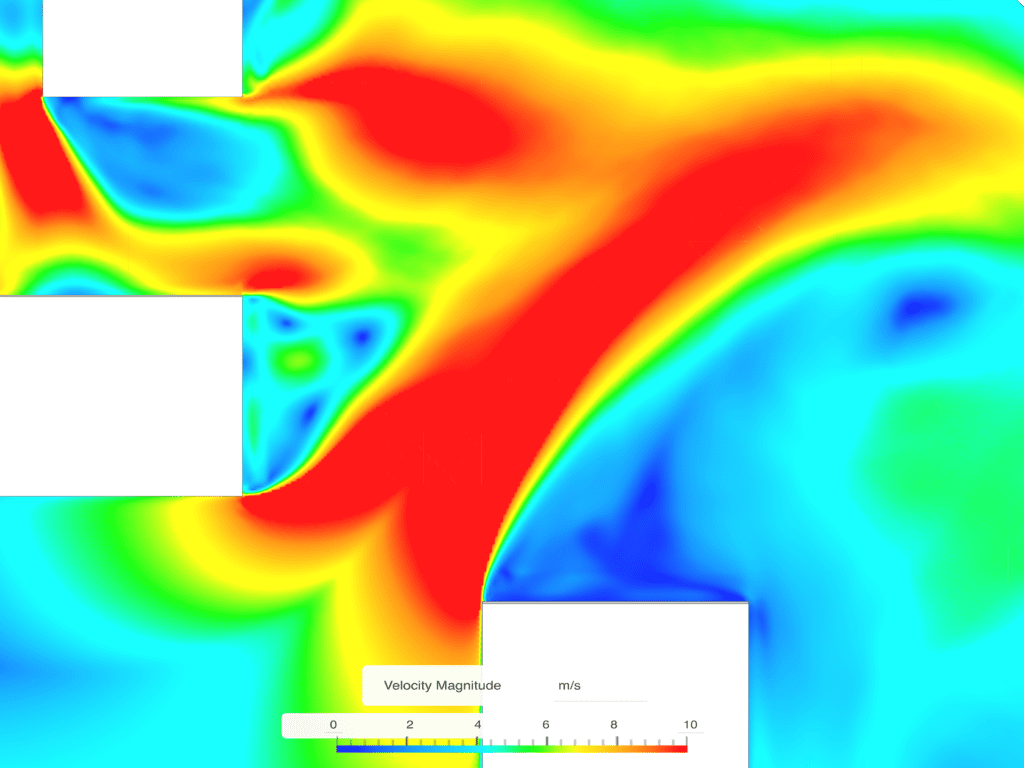
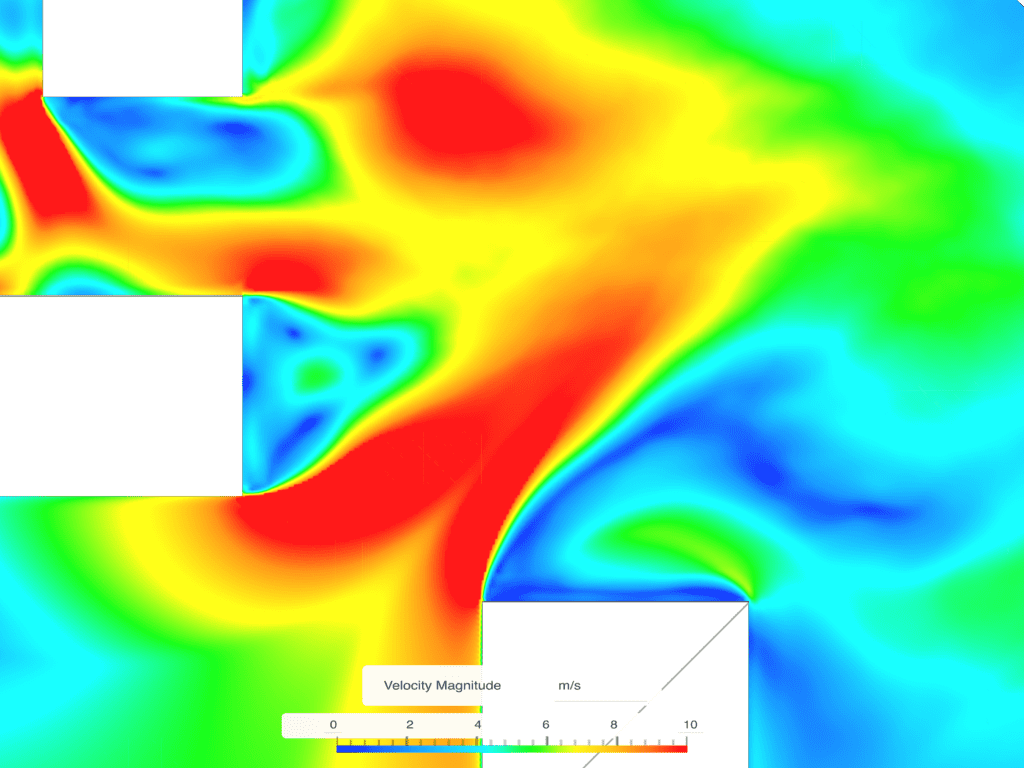
2. Landscaping
Integrating landscaping elements into urban environments can be an effective strategy for mitigating the channeling effect. Well-placed trees, shrubs, and hedges can act as natural windbreaks, reducing street-level wind velocities and creating more pleasant pedestrian spaces.
Key points to consider:
- Strategically plant trees, shrubs, and hedges to serve as windbreaks.
- Focus on areas prone to wind acceleration, such as open spaces or along streets.
- Choose wind-resistant plant species for effective wind barrier creation.
An example of this concept is shown below, using a tree line and bordering shrubbery to break the wind’s path.

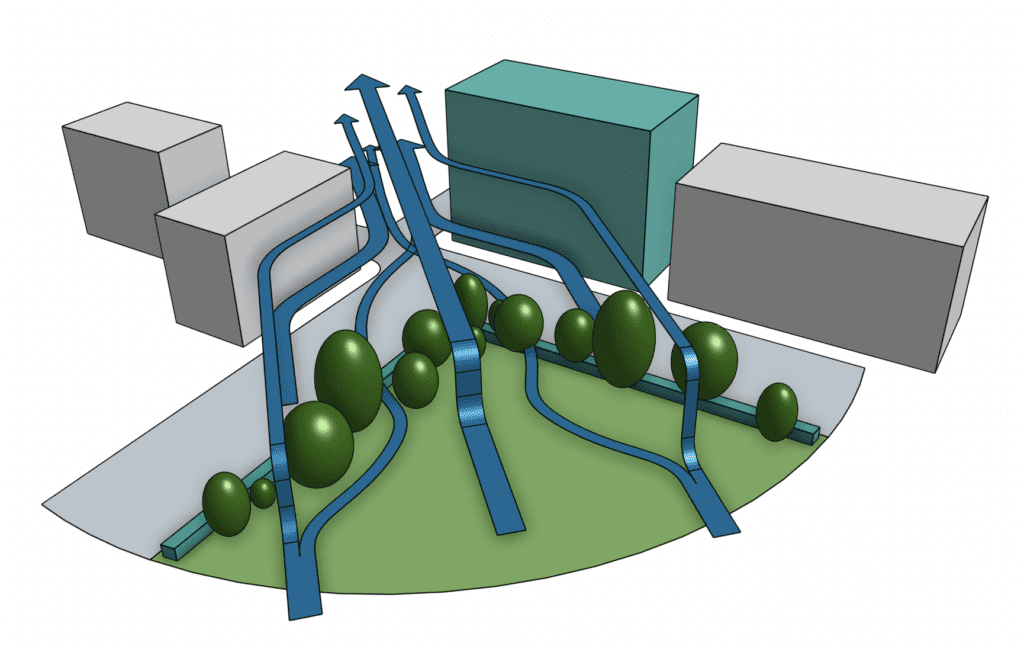
In our design for the street corner, we strategically incorporate a lush arrangement of trees and shrubs to mitigate the channeling effect and improve pedestrian wind comfort effectively. Placed on the windward side of the corner, these green elements act as natural windbreaks, persuading the airflow up and over the tree line. As the prevailing wind from the southwest encounters this green barrier, it is deflected and forced to rise above the tree canopy, preventing it from being channeled and intensified between the buildings at ground level.
This strategic placement of trees and shrubs helps disperse the wind more evenly, reducing wind speeds and creating a more tranquil environment for pedestrians. The greenery contributes to mitigating the channeling effect and enhances the aesthetics and sustainability of the urban landscape, providing a serene and inviting space for people to enjoy.



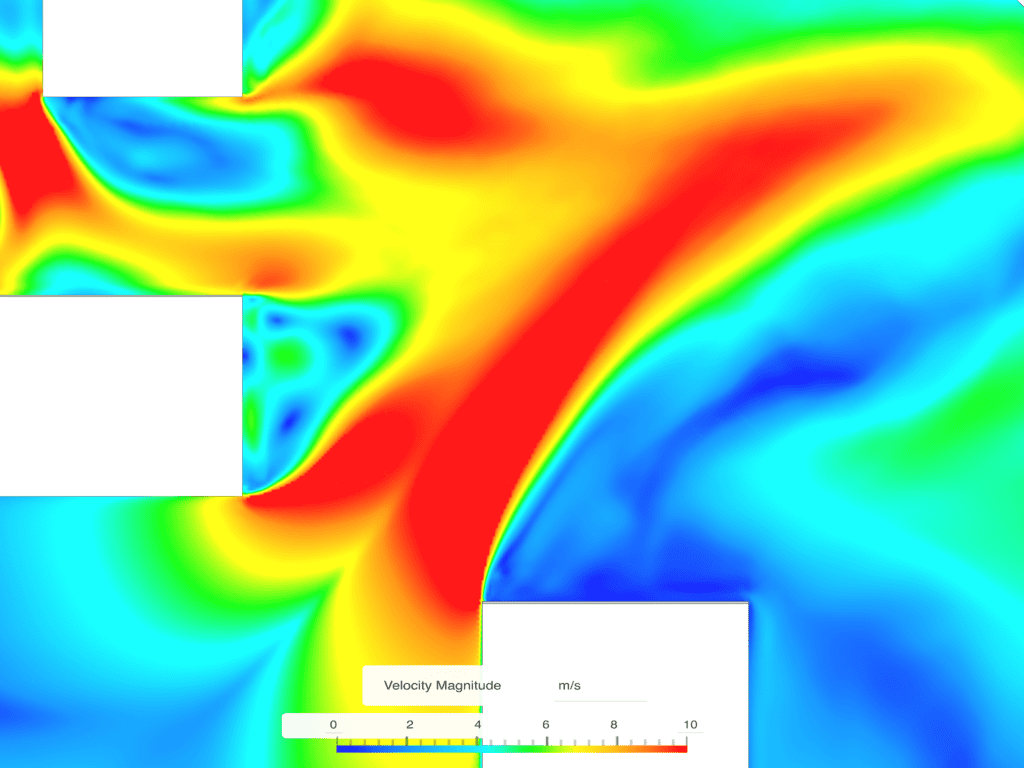
3. Street Furniture and Structures
Street furniture and structures can be strategically positioned to disrupt wind flow and provide sheltered areas for pedestrians. By incorporating these elements, urban environments can minimize the impact of the channeling effect and enhance pedestrian comfort.
Key points to consider:
- To disrupt wind flow, install street furniture like benches, planters, or bollards.
- Design wind baffles, fences, or deflectors to redirect wind and reduce its impact.
- Consider the placement of bus shelters, kiosks, or urban elements as windbreaks.
In the illustrating example, we put a concrete sculpture in the corner of the park that acts not only as a sitting area and a sound barrier to the road but also as a wind deflector. A pedestrian footbridge is also introduced with mounted traffic signage.

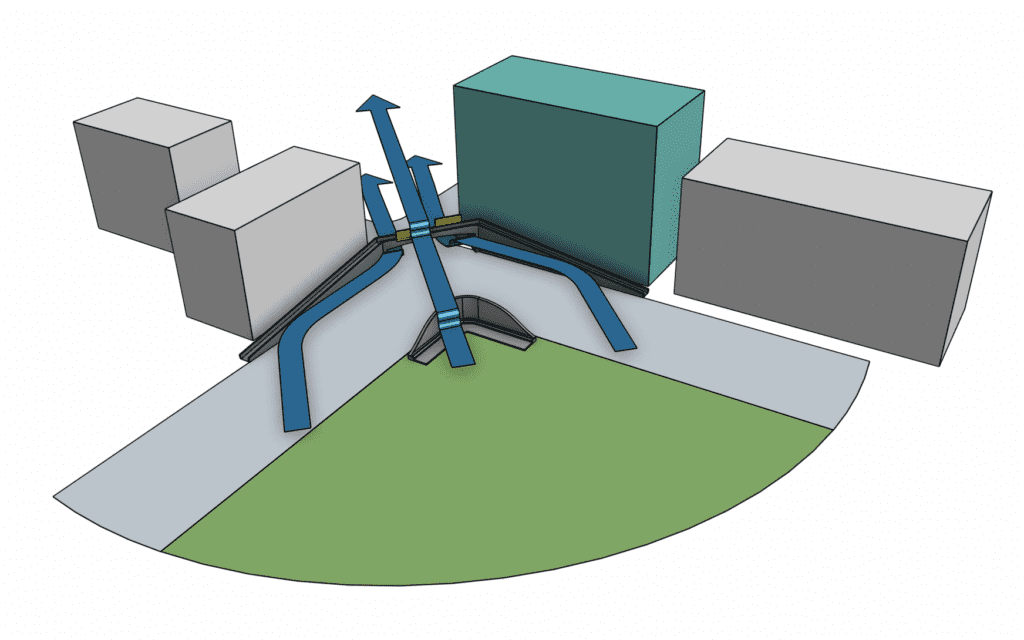
The strategic introduction of a concrete sculpture acting as a wind deflector and a pedestrian footbridge with mounted traffic signage in our street corner scenario mitigates the channeling effect and improves pedestrian wind comfort.
Utilizing Computational Fluid Dynamics (CFD) analysis, we observe the comfort plots revealing reduced wind discomfort and gusts near the corner, thanks to the sculpture’s wind redirection capabilities. The footbridge further enhances wind deflection, resulting in a noticeable decrease in wind velocities in the pedestrian zone. This technical mitigation approach creates a more tranquil and inviting urban space, providing pedestrians with a comfortable environment to enjoy their surroundings, even in wind-prone conditions.

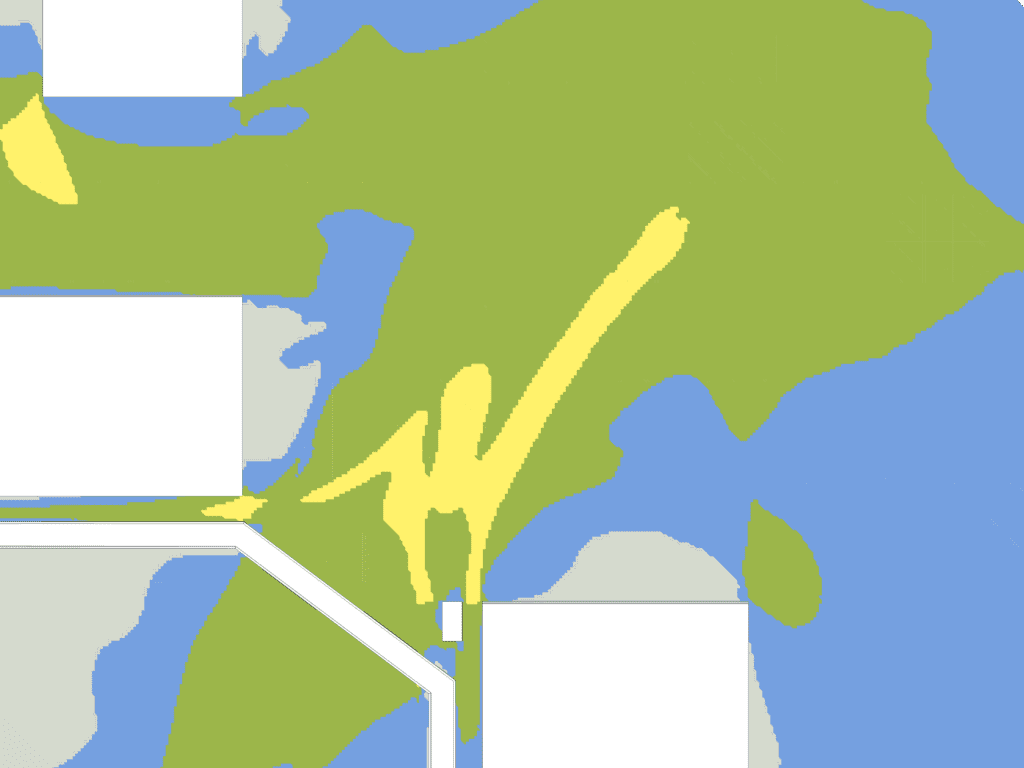

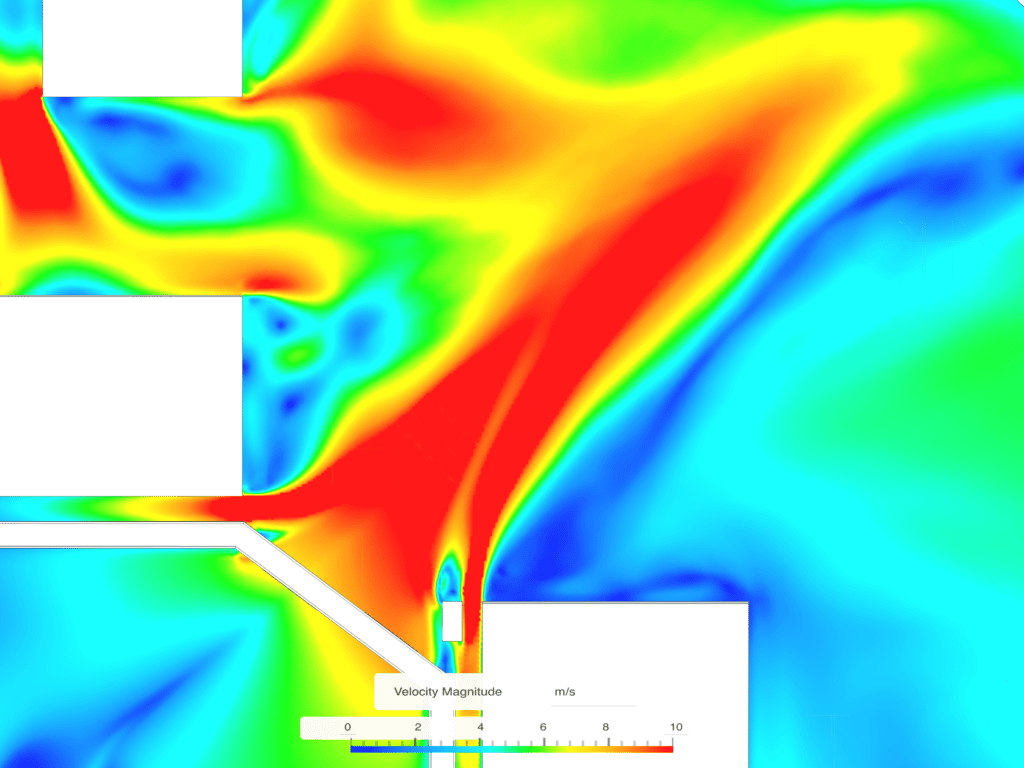
4. Urban Layout and Planning
Effective urban layout and planning can help alleviate the channeling effect and create more comfortable pedestrian spaces. By considering the arrangement of streets, buildings, and open spaces, planners can promote better airflow and reduce wind-related discomfort.
Key points to consider:
- Design a well-organized street network with curved or staggered layouts.
- Incorporate open spaces, plazas, and squares strategically for wind dissipation.
This time, to demonstrate layout and planning, we split the building into two, with one smaller building on the corner, and made the larger building miss the channeling corner, ensuring the pair maintained the same approximate floor space.

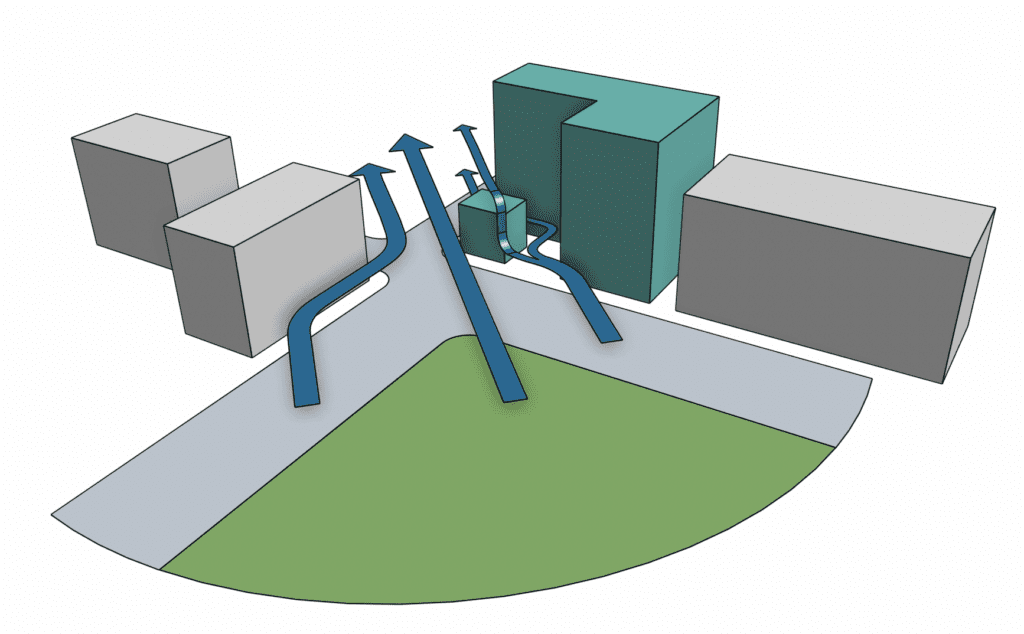
In the split site layout, the wind can travel through the site, effectively reducing the channeling effect. Additionally, the presence of the smaller building acts as a deflector, guiding the wind upward and over itself. This combined approach proves highly effective in mitigating the noticeable discomfort caused by the channeling effect. As a result, pedestrians experience improved wind comfort in the area, making the urban environment more inviting and enjoyable.



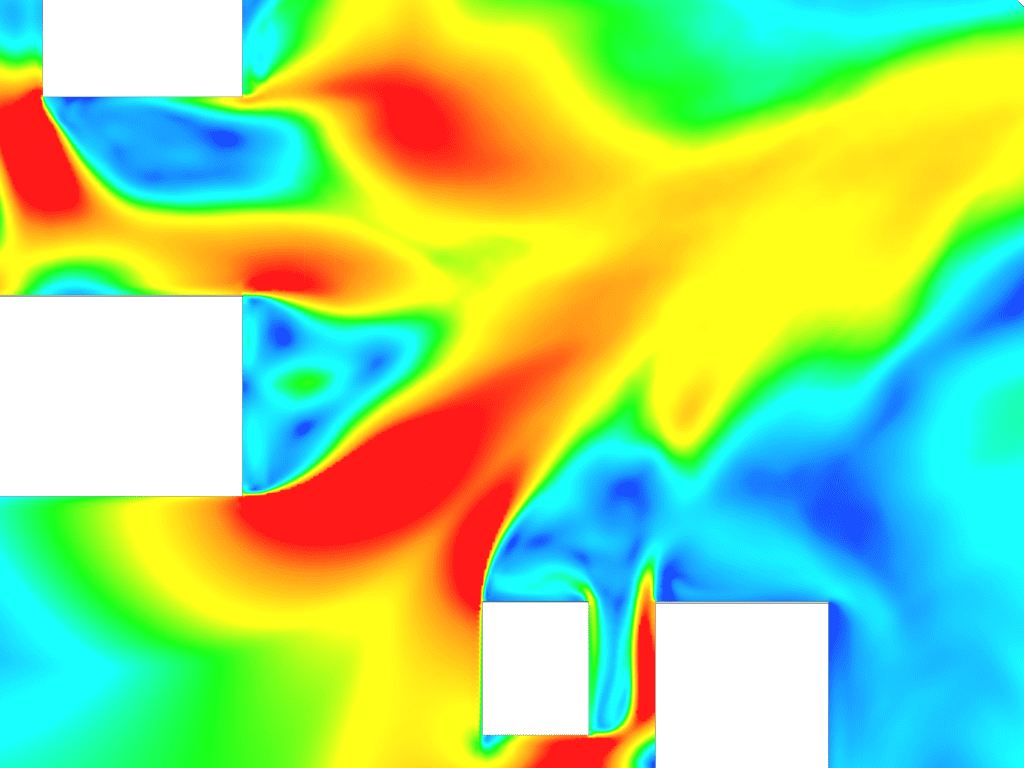
5. Computer Simulations and Wind Studies
Computational Fluid Dynamics (CFD) has emerged as a powerful tool in mitigating the channeling effect (Venturi effect) in urban design. By simulating and analyzing wind flow patterns, pressure distributions, and velocity fields around buildings and street corners, CFD provides invaluable insights into the complex dynamics of wind behavior, enabling designers to optimize mitigation strategies.
One of the key applications of CFD in mitigating the channeling effect is the generation of comfort plots or comfort maps. These visual representations offer a comprehensive view of the impact of wind on pedestrian comfort in a designated area. By analyzing comfort plots, designers can identify zones where wind intensification occurs, leading to uncomfortable conditions for pedestrians. This information allows for the strategic placement of windbreaks, barriers, and other street furniture objects to disperse wind flow and create more comfortable pedestrian spaces.
In addition to comfort plots, CFD simulations provide accurate wind speed data. By understanding wind speeds in different areas, designers can pinpoint locations where wind velocities are particularly high due to channeling. Armed with this knowledge, they can implement architectural adjustments, such as building orientation, shape modifications, or adding wind deflectors, to mitigate the intensified wind flow and reduce wind speeds at ground level.
One of the key advantages of using CFD in early-stage urban design is the ability to optimize and retest mitigation strategies before physical construction begins. CFD simulations allow designers to explore various design scenarios and test different wind mitigation measures virtually. This iterative approach enables them to fine-tune and refine their designs for optimal wind comfort while reducing the potential costs of implementing changes at later stages.
Overall, CFD plays a crucial role in the mitigation of the channeling effect, providing designers with a detailed understanding of wind behavior and its impact on pedestrian comfort. By utilizing comfort plots, wind speed data, and the ability to optimize and retest designs, CFD empowers designers to create more wind-resilient and pedestrian-friendly urban environments from the early stages of planning, enhancing the overall livability and sustainability of our cities.
Conclusion
In conclusion, our exploration of mitigating the channeling effect in urban design has revealed a wealth of strategies to enhance pedestrian wind comfort. By leveraging innovative approaches, such as carefully oriented building designs, windbreaks, and strategic site layouts, we can effectively disperse wind flow and minimize the channeling effect’s impact. Utilizing Computational Fluid Dynamics (CFD) analysis and comfort plots, we gain valuable insights into wind behavior, allowing us to design more harmonious and people-centric urban spaces.
Through the incorporation of greenery, sculptures, footbridges, and other street furniture, we create multifunctional elements that not only beautify the landscape but also act as wind deflectors and barriers. The successful integration of these technical interventions results in significant reductions in wind speeds and turbulence, leading to more pleasant and comfortable environments for pedestrians.
As cities continue to evolve and urban spaces become more dynamic, addressing wind-related challenges becomes a crucial aspect of designing inclusive and enjoyable environments. By embracing these strategies and merging artistic vision with scientific analysis, we can shape cities that thrive in harmony with nature, providing optimal wind comfort and ensuring the well-being of their inhabitants.
In our pursuit of better urban living, the mitigation of the channeling effect stands as a testament to the powerful interplay between design ingenuity, technological advancements, and the aspiration to create sustainable, vibrant, and welcoming cities for generations to come. Together, let us continue this journey towards wind-resilient, pedestrian-friendly urban landscapes that celebrate both form and function, enriching our lives as we traverse the bustling city streets with comfort and ease.
